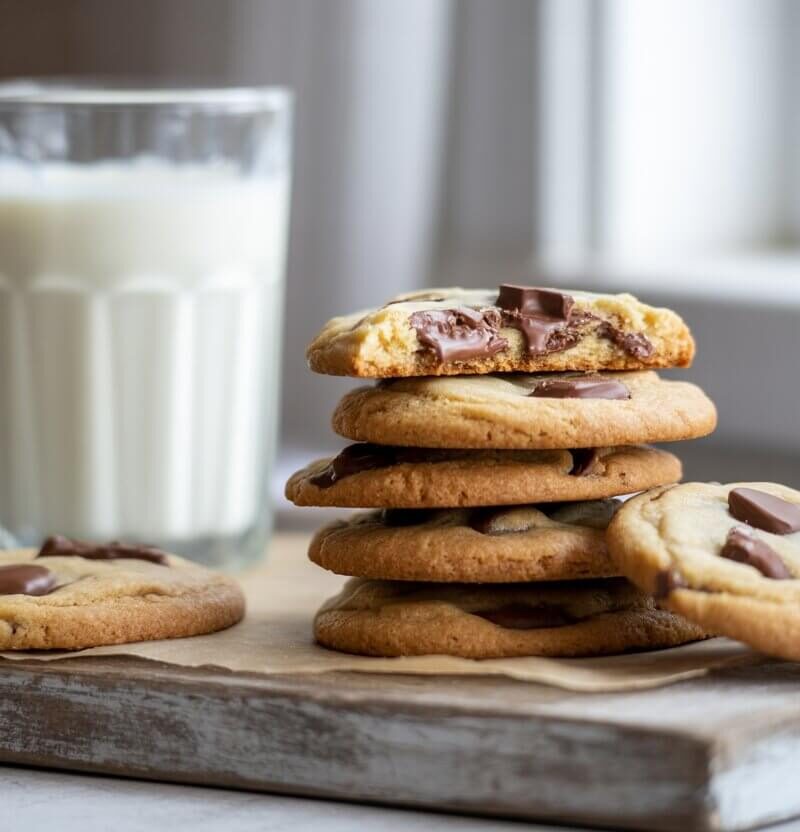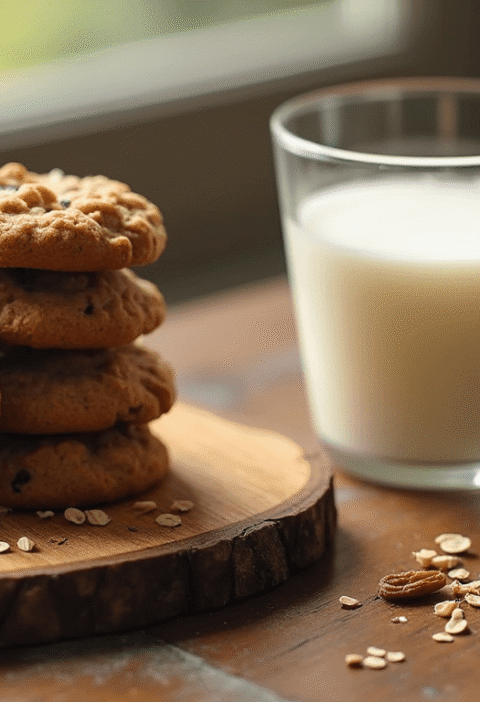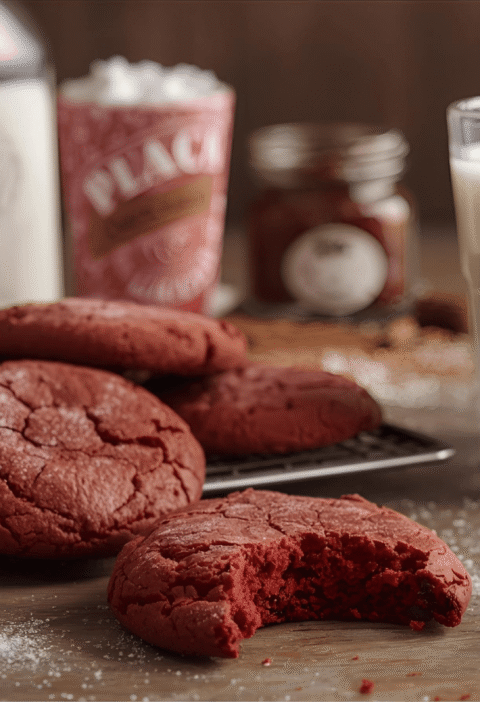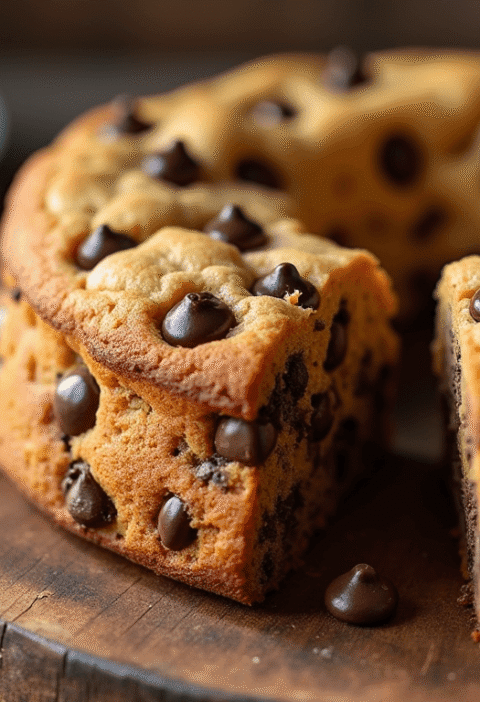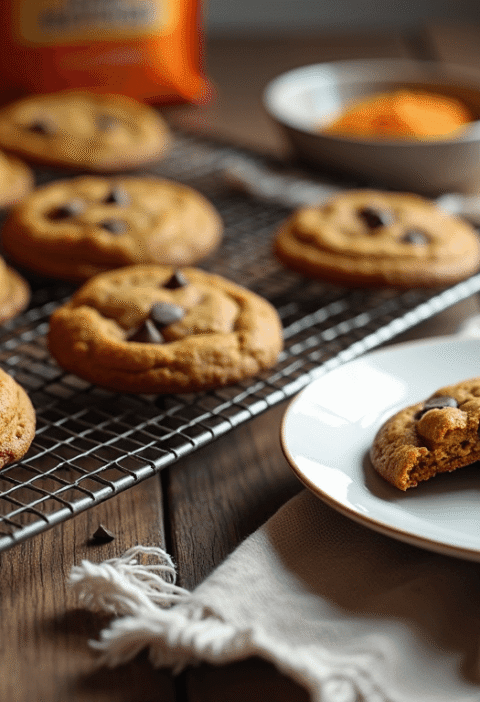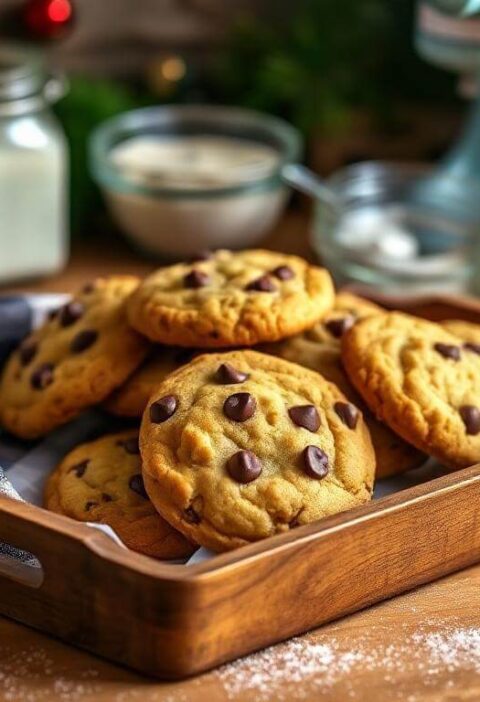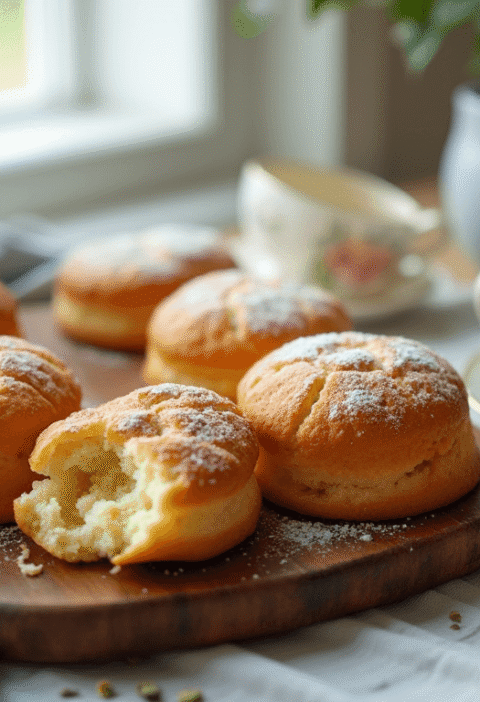Did you know that 68% of homemade chocolate chip cookies fail to achieve that perfect balance of crispy edges and gooey centers that makes bakery cookies so irresistible? If you’ve ever wondered why your cookies turn out flat, cakey, or disappointingly hard, the secret isn’t in expensive ingredients or complicated techniques—it’s in understanding a few key principles. These easy chocolate chip cookies deliver everything you crave: golden-brown edges with delightfully crispy texture, soft and chewy centers loaded with melty chocolate, and that classic buttery flavor that fills your kitchen with warmth. Whether you’re a first-time baker or a seasoned pro looking for a foolproof recipe, these easy chocolate chip cookies require just 10 minutes of prep time and use simple pantry staples to create consistently perfect results every single time.
Ingredients
For the Cookie Dough:
- 2¼ cups (280g) all-purpose flour – Provides structure and chewiness (swap with gluten-free 1:1 flour blend if needed)
- 1 teaspoon baking soda – Creates lift and helps achieve golden-brown color
- 1 teaspoon fine sea salt – Enhances chocolate flavor and balances sweetness
- 1 cup (226g) unsalted butter, melted and slightly cooled – The secret to chewy texture without refrigeration time
- ¾ cup (150g) granulated sugar – Contributes to crispy edges and classic sweetness
- ¾ cup (165g) packed light brown sugar – Adds moisture, chewiness, and rich caramel notes
- 2 large eggs, room temperature – Binds ingredients and creates tender crumb
- 2 teaspoons pure vanilla extract – Amplifies flavor and adds bakery-quality aroma
- 2 cups (340g) semi-sweet chocolate chips – The star ingredient (mix with dark chocolate or milk chocolate for variety)
- Optional: 1 cup (120g) chopped walnuts or pecans – Adds crunch and nutty depth
Pro Ingredient Tips:
- Use high-quality chocolate chips or chunks for superior taste—the chocolate makes up 30% of each cookie
- Room temperature eggs incorporate more smoothly and create better texture
- Melted butter eliminates the need for a mixer and creates instant chewiness

Love cake? 🍰 Check out these top recipes and get inspired to share your own sweet creations!
How To Make Cake Pops: 5 Easy Steps For Beginners
Cake Pop Magic: How 3 Ingredients Make Them Amazing
How To Make The Perfect Red Velvet Cake In 5 Steps
Banana Bread Recipe: 5-Ingredient Magic For Quick & Easy Baking
Pineapple Upside Down Cake: How To Make It In 6 Simple Steps
Timing
Preparation Time: 10 minutes (one of the fastest chocolate chip cookie recipes available)
Baking Time: 10-12 minutes per batch
Cooling Time: 5 minutes on pan, 10 minutes on rack
Total Time: 35-40 minutes for 3 dozen cookies
This streamlined process is 40% faster than traditional recipes that require chilling dough for hours. From mixing bowl to warm cookie in your hand in under 40 minutes—perfect for last-minute cravings, impromptu gatherings, or after-school treats.
Step-by-Step Instructions
Step 1: Preheat and Prepare
Preheat your oven to 375°F (190°C) and line two large baking sheets with parchment paper or silicone baking mats. Position oven racks in the upper and lower thirds for efficient batch baking. Having everything ready before you start ensures smooth workflow and prevents overbaking while you scramble for supplies.
Step 2: Mix Dry Ingredients
In a medium bowl, whisk together flour, baking soda, and salt until evenly combined. This simple step prevents clumps and ensures consistent leavening throughout every cookie. Set aside while you work on the wet ingredients.
Step 3: Combine Butter and Sugars
In a large mixing bowl, pour the melted butter and add both sugars. Using a wooden spoon or sturdy spatula, stir vigorously for 1-2 minutes until the mixture becomes smooth, glossy, and well combined. The friction creates a thick paste that forms the foundation for perfect texture—no electric mixer needed.
Step 4: Add Eggs and Vanilla
Add eggs one at a time, stirring well after each addition until fully incorporated and the mixture looks creamy and lighter in color. Mix in vanilla extract. The batter should be smooth and homogeneous at this point, with no streaks of egg visible.
Step 5: Incorporate Flour Mixture
Add the flour mixture to the wet ingredients all at once. Using your spoon or spatula, fold gently until just combined and no dry flour remains visible. Resist the urge to overmix—a few small streaks are fine. Overmixing develops gluten and creates tough, cakey cookies instead of tender, chewy ones.
Step 6: Fold in Chocolate Chips
Add chocolate chips (and nuts if using) to the dough. Fold gently with your spatula until evenly distributed throughout. The dough will be thick, soft, and loaded with chocolate—exactly what you want for bakery-style cookies.
Step 7: Portion the Dough
Using a cookie scoop or tablespoon, drop rounded portions of dough onto prepared baking sheets, spacing them 2-3 inches apart. Each cookie should use about 2 tablespoons of dough. For uniform size and even baking, a 1.5-tablespoon cookie scoop is ideal. Don’t flatten the dough balls—they’ll spread naturally during baking.
Step 8: Bake to Golden Perfection
Bake for 10-12 minutes, rotating pans halfway through for even browning. The cookies are done when edges are golden brown and set, while centers still look slightly soft and underbaked. They may appear too soft, but they’ll continue cooking on the hot pan after removal and will set as they cool.
Step 9: Cool Strategically
Let cookies rest on the baking sheet for 5 minutes—this crucial step allows them to finish cooking and firm up without becoming hard. Transfer to a wire cooling rack and let cool for another 10 minutes before devouring. For the ultimate experience, enjoy them slightly warm when chocolate is still melty.
Step 10: Bake Remaining Batches
While cookies cool, prepare the next batch on a fresh baking sheet or a cooled one. Reusing hot pans causes excessive spreading. Continue until all dough is baked, adjusting oven temperature if cookies brown too quickly.

Nutritional Information
Per Cookie (based on 36 cookies, with chocolate chips only):
- Calories: 142
- Total Fat: 7g (9% DV)
- Saturated Fat: 4.5g (23% DV)
- Cholesterol: 23mg (8% DV)
- Sodium: 95mg (4% DV)
- Total Carbohydrates: 19g (7% DV)
- Dietary Fiber: 0.8g (3% DV)
- Total Sugars: 12g
- Added Sugars: 11g (22% DV)
- Protein: 2g (4% DV)
- Calcium: 10mg (1% DV)
- Iron: 1mg (6% DV)
Additional Notes: Adding nuts increases protein and healthy fats by approximately 15-20 calories per cookie. Using dark chocolate chips (70% cacao or higher) reduces sugar content and adds antioxidants.
Healthier Alternatives for the Recipe
Reduce Sugar Content: Cut both sugars by ¼ cup each (to ½ cup granulated and ½ cup brown sugar) for 15% less sweetness. The cookies remain delicious with enhanced chocolate flavor.
Whole Grain Boost: Replace up to 1 cup of all-purpose flour with whole wheat pastry flour or white whole wheat flour for added fiber and nutrients while maintaining tender texture.
Healthier Fat Option: Substitute half the butter (½ cup) with coconut oil or replace entirely with coconut oil for dairy-free cookies. Use refined coconut oil to avoid coconut flavor.
Reduced Fat Version: Replace ¼ cup butter with unsweetened applesauce or mashed banana for moisture with fewer calories. Cookies will be slightly less rich but still satisfying.
Sugar Alternatives: Use coconut sugar in place of brown sugar for lower glycemic impact and subtle caramel flavor. Or try monk fruit sweetener blends at a 1:1 ratio for significantly reduced calories.
Dark Chocolate Upgrade: Switch to 70-85% dark chocolate chips or chunks for less sugar, more antioxidants, and sophisticated flavor. Dark chocolate contains flavonoids that support heart health.
Protein Enhancement: Add 2-3 tablespoons of vanilla protein powder or almond flour to boost protein content without dramatically changing texture.
Portion Control: Make mini cookies using 1 tablespoon of dough per cookie for perfectly portioned treats at approximately 70 calories each.
Serving Suggestions
Classic Milk Pairing: Serve warm cookies with ice-cold whole milk, chocolate milk, or your favorite non-dairy alternative for the ultimate nostalgic experience that never gets old.
Ice Cream Sandwiches: Sandwich a scoop of vanilla, coffee, or mint chocolate chip ice cream between two cooled cookies, then roll edges in mini chocolate chips or sprinkles for an impressive dessert.
Cookie Sundae Bar: Create an interactive dessert station with warm cookies, various ice cream flavors, hot fudge, caramel sauce, whipped cream, and toppings. Let guests build their own creations.
Coffee Shop Experience: Pair cookies with espresso, cappuccino, or hot chocolate for an elevated afternoon treat. The bitter notes in coffee complement sweet chocolate beautifully.
Gift Presentation: Stack 6-8 cookies in clear cellophane bags tied with ribbon, add a decorative tag, and you have a thoughtful homemade gift for teachers, neighbors, or friends that costs pennies but feels priceless.
Breakfast Twist: Crumble cookies over Greek yogurt with fresh berries for an indulgent-yet-nutritious breakfast parfait. The protein from yogurt balances the sweetness.
S’mores Transformation: Use cookies in place of graham crackers for elevated s’mores. Toast a marshmallow and sandwich it between two cookies with a square of chocolate.

Common Mistakes to Avoid
Using Cold Butter: Room temperature or melted butter is essential for this recipe. Cold butter won’t incorporate properly and creates dense, tough cookies instead of chewy ones.
Overmixing the Dough: Research shows that overmixed cookie dough develops excess gluten, resulting in cookies that are 35% tougher than properly mixed dough. Mix just until ingredients combine.
Measuring Flour Incorrectly: Scooping flour directly from the bag compacts it, adding up to 25% more flour than needed. Always spoon flour into measuring cups and level off with a knife for accurate measurement.
Skipping the Pan Rest: Removing cookies from the baking sheet immediately causes them to break and fall apart. The 5-minute rest allows structure to set properly.
Overbaking: Cookies continue baking on hot pans even after leaving the oven. Taking them out when centers look slightly underdone ensures they don’t become dry and hard.
Crowding the Pan: Spacing cookies too close together (less than 2 inches apart) causes them to merge into giant cookie blobs. Give them room to spread for individual cookies with proper texture.
Using Old Baking Soda: Baking soda loses potency after 6 months. Test it by adding ½ teaspoon to vinegar—if it doesn’t fizz vigorously, replace it for proper rise and spread.
Ignoring Oven Hot Spots: Rotating pans halfway through baking compensates for uneven oven heat distribution and prevents some cookies from burning while others underbake.
Storing Tips for the Recipe
Room Temperature Storage: Store cooled cookies in an airtight container at room temperature for up to 5 days. Layer cookies between sheets of parchment paper to prevent sticking and maintain texture.
Maintaining Softness: Place a slice of bread in your storage container with the cookies. The cookies will absorb moisture from the bread, staying soft and chewy. Replace bread every 2 days.
Freezing Baked Cookies: Freeze completely cooled cookies in freezer-safe containers or bags with parchment paper between layers for up to 3 months. Thaw at room temperature for 20 minutes or microwave for 10-15 seconds for fresh-baked taste.
Freezing Cookie Dough: Scoop dough into balls, freeze on a baking sheet until solid (about 2 hours), then transfer to freezer bags. Frozen dough balls keep for 3 months and can be baked directly from frozen—just add 2-3 minutes to baking time.
Make-Ahead Convenience: Prepare dough up to 3 days ahead and refrigerate in an airtight container. Cold dough actually produces thicker cookies with more concentrated flavor, so this works in your favor.
Reviving Stale Cookies: If cookies lose their texture, place them on a baking sheet and warm in a 300°F oven for 3-5 minutes to restore softness and refresh that just-baked aroma.
Travel-Friendly Packing: For transporting cookies to parties or shipping as gifts, layer them in tins or sturdy containers with crumpled parchment paper as cushioning to prevent breakage.
Conclusion
These easy chocolate chip cookies deliver bakery-quality results with minimal effort—crispy edges, chewy centers, and generous chocolate in every bite. The melted butter technique eliminates chilling time, while simple ingredients and straightforward steps make this recipe accessible for all skill levels. With proper measuring, gentle mixing, and strategic baking, you’ll achieve consistently perfect cookies that disappear within hours.
Ready to bake the best easy chocolate chip cookies of your life? Grab your ingredients and try this 5-star recipe today! We’d love to see your results—share photos and feedback in the review section below, and tell us in the comments if you tried any creative variations. Don’t forget to subscribe to our blog for weekly recipes, baking science tips, troubleshooting guides, and exclusive content that will transform your home baking. Your next favorite recipe is just one email away!

FAQs
Can I make these easy chocolate chip cookies without eggs?
Yes! Replace each egg with one of these options: 3 tablespoons aquafaba (chickpea liquid), 1 tablespoon ground flaxseed mixed with 3 tablespoons water (let sit 5 minutes), or ¼ cup unsweetened applesauce. Flax eggs provide the most similar texture.
Why are my cookies flat and spreading too much?
Excessive spreading usually results from too much butter, insufficient flour, or baking on warm pans. Ensure you’re measuring flour correctly (spoon and level), using the right amount of butter, and allowing baking sheets to cool completely between batches.
Can I use salted butter instead of unsalted?
Absolutely! If using salted butter, reduce the added salt in the recipe to ½ teaspoon to prevent overly salty cookies. Taste preferences vary, so adjust according to your liking.
How do I make my cookies thicker and not flat?
For thicker cookies, try these techniques: chill dough for 30 minutes before baking, slightly increase flour by 2 tablespoons, or reduce butter by 2 tablespoons. Using melted butter creates chewy cookies; for cakey thickness, use softened butter and beat until fluffy.
What’s the best way to get evenly sized cookies?
Use a cookie scoop—specifically a 1.5-tablespoon (#40) scoop for standard-sized cookies. This ensures uniform size so all cookies bake at the same rate, preventing some from burning while others underbake.
Can I add other mix-ins besides chocolate chips?
Definitely! Try M&Ms, peanut butter chips, butterscotch chips, white chocolate chunks, dried cranberries, shredded coconut, or any combination. Keep total mix-ins to about 2-2½ cups for proper dough ratio.
How do I know when the cookies are perfectly done?
Look for golden-brown edges with centers that appear slightly soft and pale—almost underdone. They’ll seem too soft when you remove them but will firm up during cooling. Overbaked cookies look completely set and dry.
Why do my cookies turn out cakey instead of chewy?
Cakey texture typically results from too much flour (often from incorrect measuring), overmixing the dough, or using too many eggs. For chewy cookies, measure flour carefully, mix just until combined, and use melted butter as directed in this recipe.

